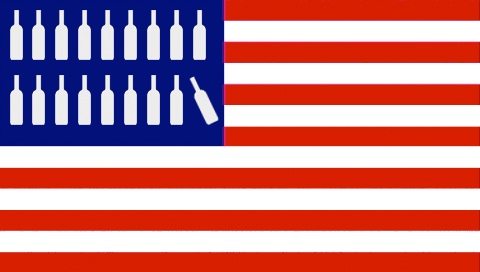
This hasn’t been a great year for U.S. wine in China. Let’s break things down in “the good, the bad and the ugly” style.
The bad: The trade war with China has translated into taxes and tariffs of 93% for U.S. wine. Compare that to ~48% for most nations and ~34% for those with a China free trade deal, like Chile and Australia.
In the first half of 2019, U.S. bottled wine imports fell 57% by value and 47% by volume, to just 1.3% market share. That’s bad. Given most of that wine arrived before the third tariff was announced, the situation is likely to get worse.
Also bad: most importers I talk to aren’t hopeful of a deal any time soon. The bulk of U.S. wine going to China comes from California, a state that voted against US President Donald Trump and that cost him the popular vote. I’m not saying that would be a factor in any deal, only that it seems to weigh, in an unhealthy way, on the minds of some. That’s also bad.
The ugly: Beyond this macro view, the impact on individual producers, importers or distributors whose main business is China’s wine market has been devastating. Simon Su, who handles Santa Barbara brands Dierberg and Star Lane, and Michael Parr, from Livermore’s Wente, explained in my Wine Searcher piece ways to absorb the first pair of tariffs: an extra 15 percent in April and 10 percent in September of 2018. The third tariff, announced June 1, pushed many past the point of making any profit. Best-case scenario? Having ample stock in China before the tariffs hit. And when that runs out?
Also ugly: The prospects of U.S. wine being politicized. It’s one thing for consumers to say no because the price has risen, it’s quite another to do so out of political principal or a fear of being seen with U.S. wine. Some importers told me of distributors and clients privately deciding to avoid U.S. wine. A public campaign to boycott U.S. wine would be very ugly.
The good: The trade war is brutal for specific producers, importers and distributors. But the exposure for the U.S. wine trade is low. Even in 2017, before the first tariff, only one of every 250 bottles was shipped to continental China, compared to one of every six to Canada.
I keep seeing quotes from wine trade people in California saying China was their fastest growing market. Reality check: During the boom years of 2011 to 2017, when the market for bottled wine in China doubled, the U.S. share plunged from 5 percent to 2 percent. Worse, the total amount of U.S. wine dropped at a time when France, Australia and others were seeing major gains.
Media coverage of the ‘damage’ of the trade war also underscores the size of the problem (my highlights):
- This story about Washington State uses the “China is the fastest growing export market for the U.S. wine” spin. Then goes on to report, “In Washington State, there are 1,000 wineries; 16 of them… ship wines to China.” Washington sends under 5% of its wine abroad: Canada, South Korea and Sweden rank among the customers bigger than China.
- Then there’s this article by Chinese state-owned media Xinhua: “U.S.-China trade war hitting Colorado wine growers.” How hard? “It hasn’t affected smaller wineries, but it has hit the industry hard,” one wine grower is quoted as saying. How hard? The only evidence of damage is an extra USD$800 for made-in-China wine bottles.
- “China tariffs putting the squeeze on winemakers” focuses on the Alexander Valley Vineyard in Sonoma County, which just started shipping to China last year. “[Co-founder Hank] Wetzel said the U.S.-China trade war won’t financially strain the California winery. ‘Thankfully it’s a relatively small part of our market, we’ve been selling and growing in the United States for about 40 years and the export market is something we’ve never really concentrated on until recently.'” [This article doesn’t mention that Wetzel is chairman of lobby group The Wine Institute.]
Thus, while it is not ideal to call this situation “good”, a reality check is needed. The U.S. drinks most of its wine. China is not a major market for what wine it does export. And even before the tariffs, the U.S. was losing share in China to countries that rely heavily on exports.
(Imagine if an export-dependent wine producer like Australia actually found itself in such an economic / political spat with China, its top customer, one that spilled over into wine. This article is worth a read.)
Finally, many Chinese consumers who drink U.S. wine know their stuff. They appreciate U.S. wine and accept they are relatively expensive, and that provides some loyalty and insulation against price increases. Some people will swallow higher prices or source elsewhere (duty-free Hong Kong is nearby). While the trade war will reduce exposure to U.S. wine in a market with so much growth potential, it’s impact on the trade at large needs to be put in context.
Sign up for the Grape Wall newsletter here. Follow Grape Wall on LinkedIn, Instagram, Facebook and Twitter. And see my sibling sites World Marselan Day, World Baijiu Day and Beijing Boyce. Grape Wall has no advertisers, so if you find the content useful, please help cover the costs via PayPal, WeChat or Alipay. Contact Grape Wall via grapewallofchina (at) gmail.com.
Leave a Reply
You must be logged in to post a comment.